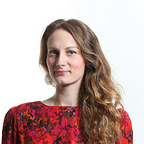SFPC Week 2: Recreating the Past
Write code to create an artwork that directly translates or responds to another artist’s.
This is the premise of Zach’s software class, otherwise known as “Recreating the Past.” As a beginner, this approach resonates with me because:
- I learn about pioneering media artists.
- I can work my training wheels with a straightforward task (i.e. directly copying another artist’s work) to make sure I understand* the code I’m typing. *Let me tell ya, at this stage it’s very tempting to just copy and paste code without really getting it. This is a trap.
- I can “graduate” my direct responses by creating more thoughtful, experimental work with more complicated code, when I feel good and ready.
It’s a threefer!* (*Not as fun to say or write as “twofer”.)
This week, we learned about Vera Molnár and John Whitney; below is my work to recreate and respond to Molnár’s work, Whitney’s is forthcoming.
__
Direct Translation
Vera Molnár laid the groundwork for computer generated art; she saw the computer as an extension of traditional artmaking (rather than a perversion of it).It made iteration easier for her and her work is characterized by repetition (although, the repetition is not exacting).
I chose this image to directly respond to:
Here is what I came up with:
This being my first assignment, there was a lot of (messy) paper sketching involved in understanding the triangle’s relationships to one another. Shoutout to our TA Matt and my classmate Gonza for helping me work through this one.
__
Experimental Response
For each assignment, we research each artist collectively — we look into what the artist was like, what they made, who influenced them, who they influenced thereafter. It is very important that we capture the artist’s voice, so that we can respond to their work respecting their intentions.
One of my favorite things Molnár said was that her code allowed her to have a “dialogue with the screen.” My response aims to embody this — to somehow make it feel like the screen is in conversation with the viewer.
Here is the Vera Molnár piece I was responding to:
Here is my response:
__
Our class produced an entire wall of Vera Molnár inspired prints, plus some other interactive programs. While I followed Vera Molnár’s aesthetic closely for this assignment, some of my more code experienced cohort went all-out and created tools that made sound or experimental visuals in response to what the computer saw through the webcam. The variety of what the class produced is a testament to how cool this assignment is.
__
This is my weekly reflection about my experience at The School of Poetic Computation. To read about my week zero, go here; week one, go here.
